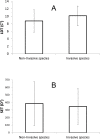Invasive Insects Differ from Non-Invasive in Their Thermal Requirements
- PMID: 26090826
- PMCID: PMC4475049
- DOI: 10.1371/journal.pone.0131072
Invasive Insects Differ from Non-Invasive in Their Thermal Requirements
Abstract
We tested whether two basic thermal requirements for insect development, lower developmental thresholds, i.e. temperatures at which development ceases, and sums of effective temperatures, i.e. numbers of day degrees above the lower developmental thresholds necessary to complete development, differ among insect species that proved to be successful invaders in regions outside their native range and those that did not. Focusing on species traits underlying invasiveness that are related to temperature provides insights into the mechanisms of insect invasions. The screening of thermal requirements thus could improve risk-assessment schemes by incorporating these traits in predictions of potentially invasive insect species. We compared 100 pairs of taxonomically-related species originating from the same continent, one invasive and the other not reported as invasive. Invasive species have higher lower developmental thresholds than those never recorded outside their native ranges. Invasive species also have a lower sum of effective temperatures, though not significantly. However, the differences between invasive and non-invasive species in the two physiological measures were significantly inversely correlated. This result suggests that many species are currently prevented from invading by low temperatures in some parts of the world. Those species that will overcome current climatic constraints in regions outside their native distribution due to climate change could become even more serious future invaders than present-day species, due to their potentially faster development.
Conflict of interest statement
Figures


References
-
- Taylor F (1981) Ecology and evolution of physiological time in insect. Am Nat 117: 1–23.
-
- Dixon AFG, Honěk A, Keil P, Kotela MAA, Šizling AL, Jarošík V (2009) Relationship between the minimum and maximum temperature thresholds for development in insects. Funct Ecol 23: 257–264.
-
- Campbell A, Frazer BD, Gilbert N, Gutierrez AP, Mackauer M (1974) Temperature requirements of some aphids and their parasites. J Appl Ecol 11: 431–438.
-
- Welch SM, Croft BA, Brunner JF, Michels MF (1978) PETE: an extension phenology modeling system for management of multi-species pest complex. Environ Entomol 7: 482–494.
-
- Jarvis CH, Baker RHA (2001) Risk assessment for nonindigenous pests, I. Mapping the outputs of phenology models to assess the likelihood of establishment. Divers Distrib 7: 223–235.
Publication types
MeSH terms
LinkOut - more resources
Full Text Sources
Other Literature Sources

